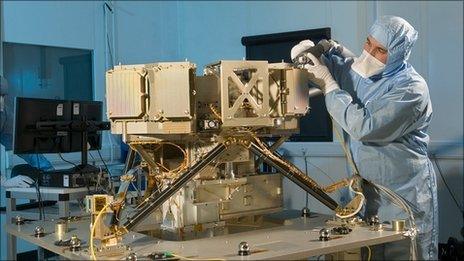Deep-space camera passes cosmic eye test
- Published

The space camera undergoes tests in Oxfordshire
Engineers in the UK have completed rigorous tests on the European camera being built for the James Webb Space Telescope.
MIRI, the Mid-Infrared Instrument, will be a key sensor on the space telescope intended as the successor to the Hubble space observatory.
After launch, the camera and spectrometer will turn its unblinking gaze on deepest space.
It will be the most powerful space observatory ever built.
The new James Webb Space Telescope (JWST) will keep its back to the Sun and orbit 1.5 million km out beyond Earth. A large shield will shade the delicate instruments from the Sun's warmth.
MIRI must be frozen to only 7 degrees above absolute zero (-266C). Only at this temperature will it gain the exquisite sensitivity needed to see the first light in the Universe.
These earliest light sources are Doppler-shifted far into the mid-infrared part of the spectrum as they race away from Earth.
The extreme cold of MIRI's eventual home presents a huge challenge to operating a complex electronic device. To make sure that the many components will work as planned, the whole sensor was put through over 2000 tests at -266C at the Rutherford Appleton Laboratory (Ral), in famously cold Oxfordshire.
After 86 days in the freezer, engineers on Thursday were able to defrost MIRI and at first inspection, all seems well, said senior engineer Paul Eccleston of Ral.
Throughout the tests, the data indicated that all systems were functioning, though only after detailed analysis will engineers know just how good MIRI's eyesight is.
The JWST is a multinational, multi-billion dollar collaboration between Nasa and the European and Canadian space agencies. Early next year, the various instruments and components that make up the JWST will be brought together in the US for assembly. Launch is scheduled for 2017.
According to Mr Eccleston, the European Space Agency's MIRI is on schedule and on budget.
Budget fears
But serious questions have been raised about the affordability of the whole James Webb project. The US House of Representatives Committee on Appropriations proposed a bill last month that will terminate the larger project's funding. They claim that it is billions of dollars over budget and plagued by poor management.
In response to this threat, the American Astronomical Society's president Dr Debra Elmegreen said that the project "will lay the foundation on which a better understanding of the early Universe will be built. It has the potential to transform astronomy even more than the Hubble Space Telescope did, and it will serve thousands of astronomers in the decades ahead. We cannot abandon it now."
Senior project scientist on the project and Nobel Prize winner Dr John Mather of Nasa's Goddard Space Flight Center said, "The James Webb Space Telescope will extend the reach of human knowledge far beyond today's limits."
"Webb will find new surprises and help to answer questions such as: when and where were the chemical elements of life synthesised, and how soon could planets and life appear after the Big Bang? Webb is about beginnings, the beginnings of everything."
The future of the JWST awaits a final vote on the 2012 budget by the US House of Representatives and Senate.
- Published7 July 2011